Unit 4 History and traditions Project 教学设计(表格式)-2024-2025学年人教版高中英语必修第二册
文档属性
| 名称 | Unit 4 History and traditions Project 教学设计(表格式)-2024-2025学年人教版高中英语必修第二册 |
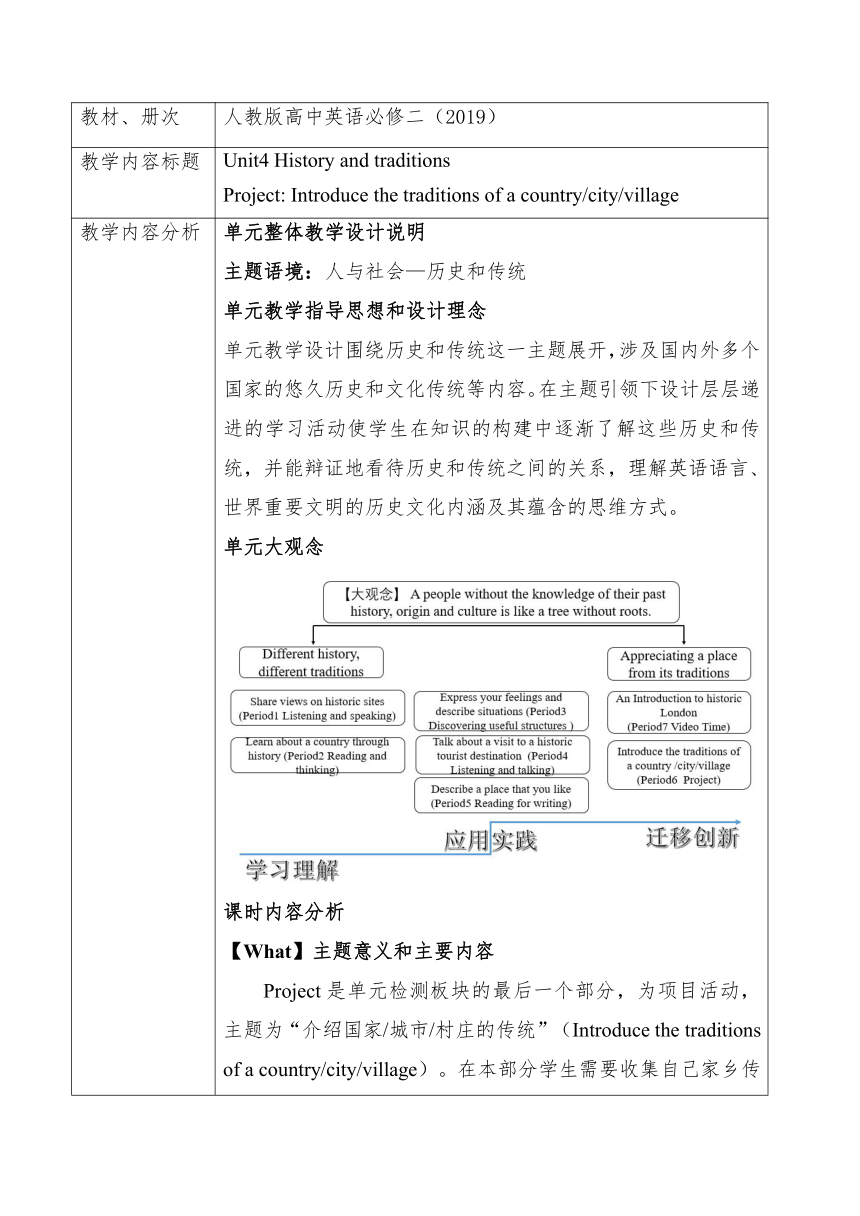
|
|
| 格式 | docx | ||
| 文件大小 | 940.9KB | ||
| 资源类型 | 教案 | ||
| 版本资源 | 人教版(2019) | ||
| 科目 | 英语 | ||
| 更新时间 | 2025-02-05 13:25:16 | ||
图片预览

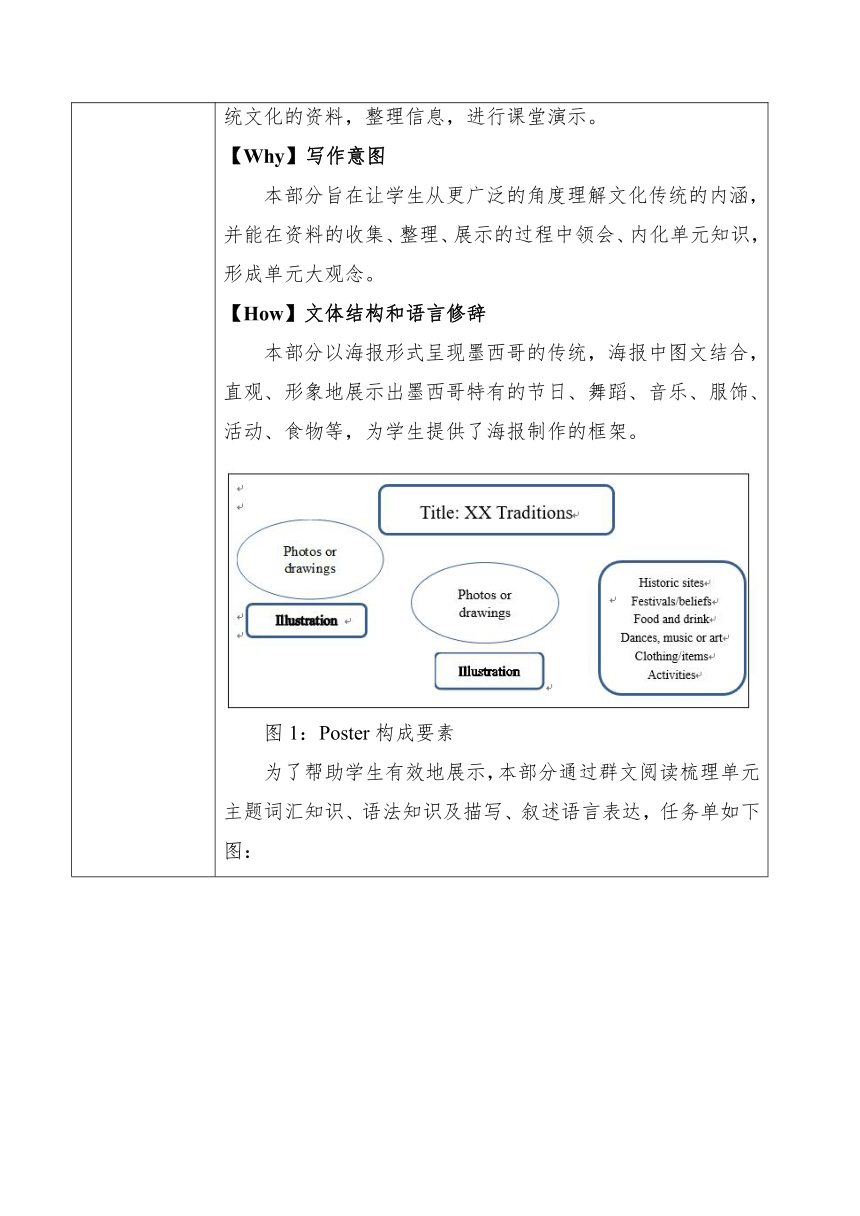
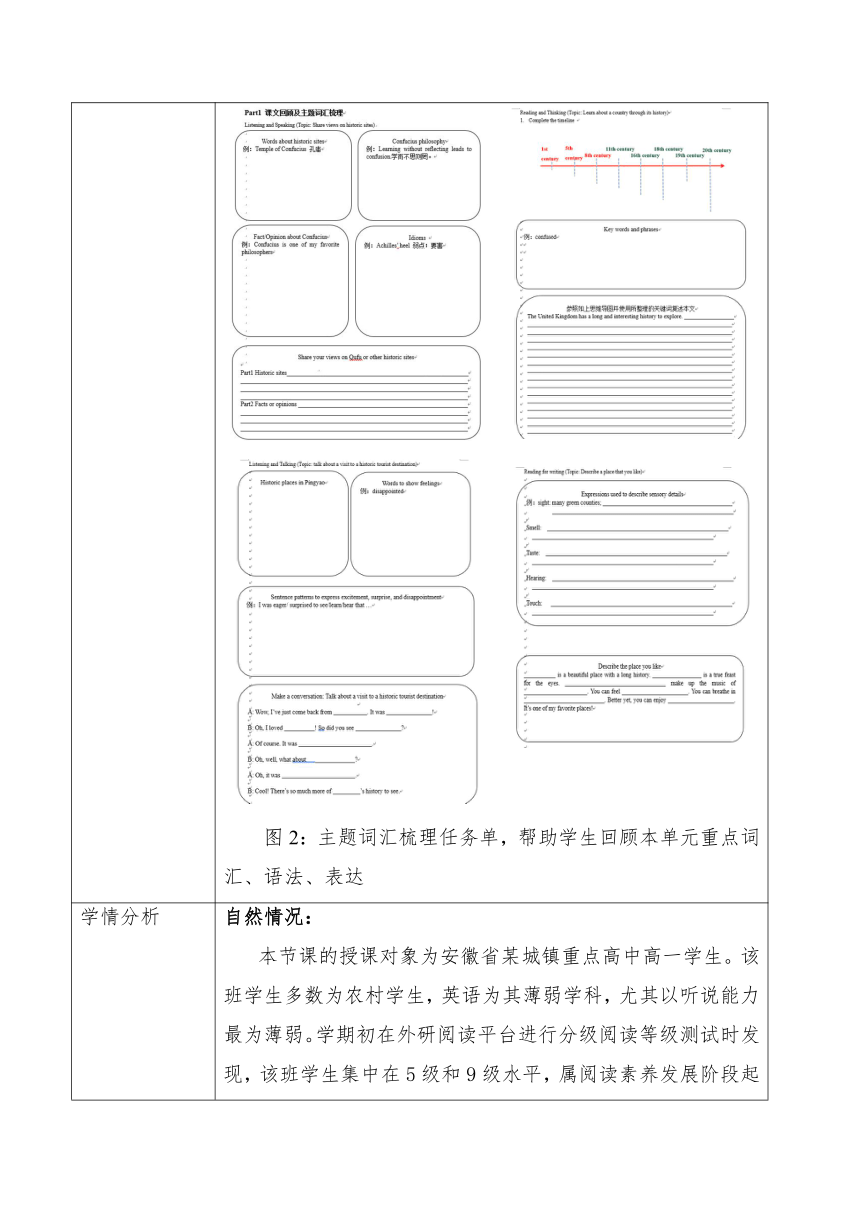
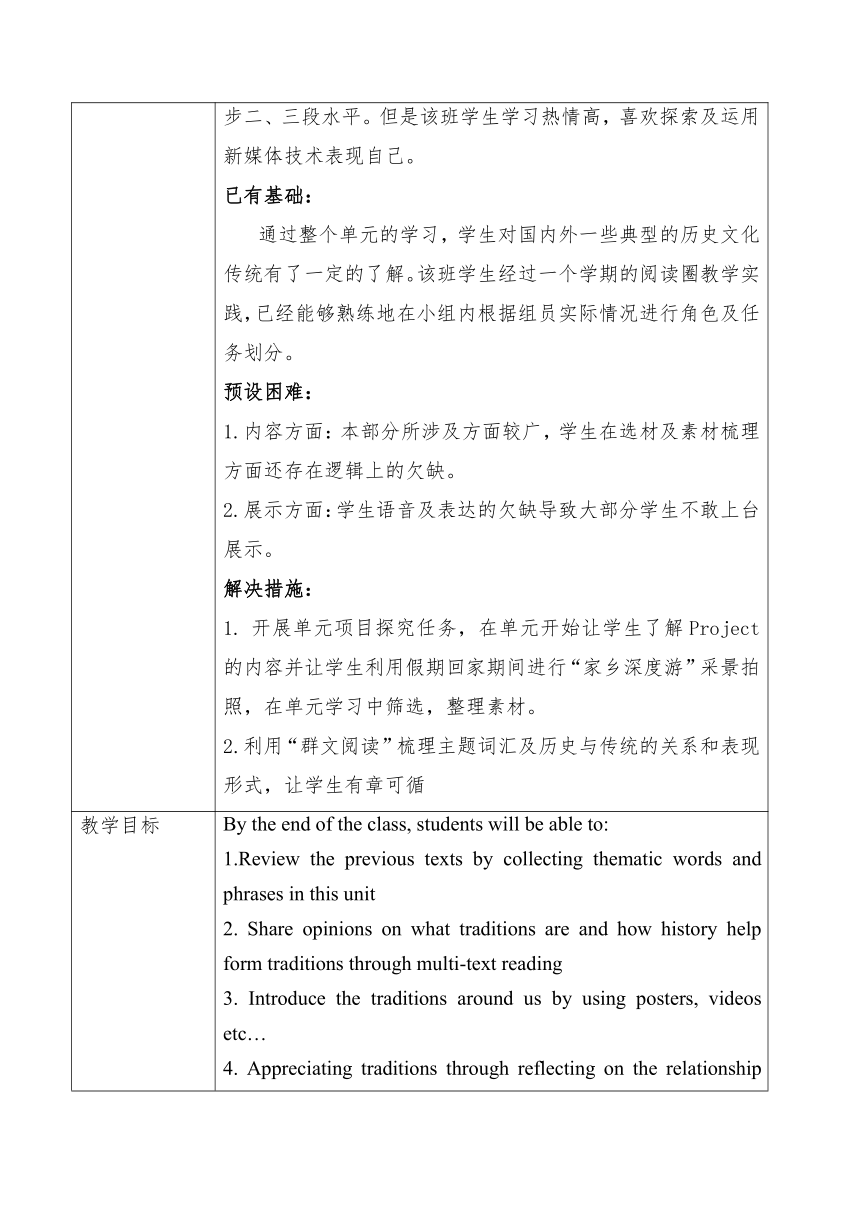
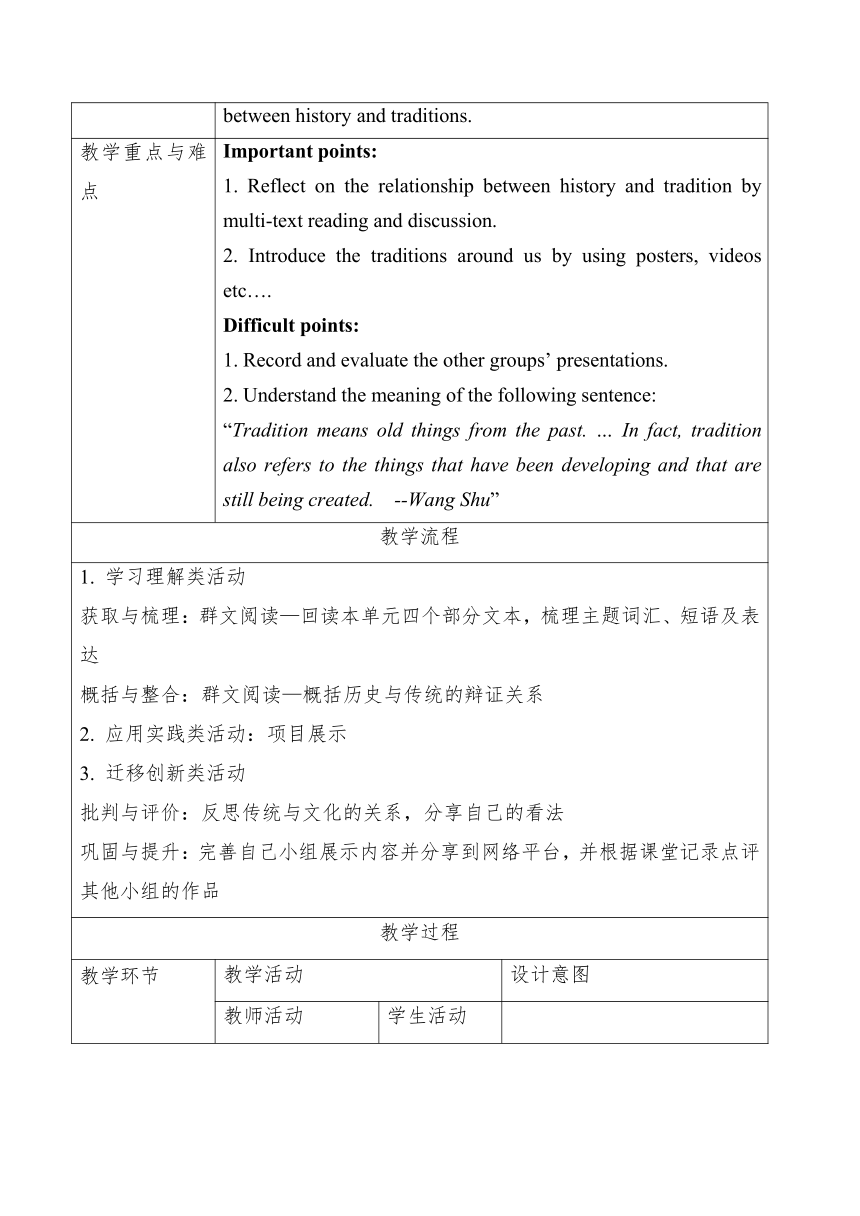
文档简介
教材、册次 人教版高中英语必修二(2019)
教学内容标题 Unit4 History and traditions Project: Introduce the traditions of a country/city/village
教学内容分析 单元整体教学设计说明 主题语境:人与社会—历史和传统 单元教学指导思想和设计理念 单元教学设计围绕历史和传统这一主题展开,涉及国内外多个国家的悠久历史和文化传统等内容。在主题引领下设计层层递进的学习活动使学生在知识的构建中逐渐了解这些历史和传统,并能辩证地看待历史和传统之间的关系,理解英语语言、世界重要文明的历史文化内涵及其蕴含的思维方式。 单元大观念 课时内容分析 【What】主题意义和主要内容 Project是单元检测板块的最后一个部分,为项目活动,主题为“介绍国家/城市/村庄的传统”(Introduce the traditions of a country/city/village)。在本部分学生需要收集自己家乡传统文化的资料,整理信息,进行课堂演示。 【Why】写作意图 本部分旨在让学生从更广泛的角度理解文化传统的内涵,并能在资料的收集、整理、展示的过程中领会、内化单元知识,形成单元大观念。 【How】文体结构和语言修辞 本部分以海报形式呈现墨西哥的传统,海报中图文结合,直观、形象地展示出墨西哥特有的节日、舞蹈、音乐、服饰、活动、食物等,为学生提供了海报制作的框架。 图1:Poster构成要素 为了帮助学生有效地展示,本部分通过群文阅读梳理单元主题词汇知识、语法知识及描写、叙述语言表达,任务单如下图: 图2:主题词汇梳理任务单,帮助学生回顾本单元重点词汇、语法、表达
学情分析 自然情况: 本节课的授课对象为安徽省某城镇重点高中高一学生。该班学生多数为农村学生,英语为其薄弱学科,尤其以听说能力最为薄弱。学期初在外研阅读平台进行分级阅读等级测试时发现,该班学生集中在5级和9级水平,属阅读素养发展阶段起步二、三段水平。但是该班学生学习热情高,喜欢探索及运用新媒体技术表现自己。 已有基础: 通过整个单元的学习,学生对国内外一些典型的历史文化传统有了一定的了解。该班学生经过一个学期的阅读圈教学实践,已经能够熟练地在小组内根据组员实际情况进行角色及任务划分。 预设困难: 1.内容方面:本部分所涉及方面较广,学生在选材及素材梳理方面还存在逻辑上的欠缺。 2.展示方面:学生语音及表达的欠缺导致大部分学生不敢上台展示。 解决措施: 1. 开展单元项目探究任务,在单元开始让学生了解Project的内容并让学生利用假期回家期间进行“家乡深度游”采景拍照,在单元学习中筛选,整理素材。 2.利用“群文阅读”梳理主题词汇及历史与传统的关系和表现形式,让学生有章可循
教学目标 By the end of the class, students will be able to: 1.Review the previous texts by collecting thematic words and phrases in this unit 2. Share opinions on what traditions are and how history help form traditions through multi-text reading 3. Introduce the traditions around us by using posters, videos etc… 4. Appreciating traditions through reflecting on the relationship between history and traditions.
教学重点与难点 Important points: 1. Reflect on the relationship between history and tradition by multi-text reading and discussion. 2. Introduce the traditions around us by using posters, videos etc…. Difficult points: 1. Record and evaluate the other groups’ presentations. 2. Understand the meaning of the following sentence: “Tradition means old things from the past. … In fact, tradition also refers to the things that have been developing and that are still being created. --Wang Shu”
教学流程
1. 学习理解类活动 获取与梳理:群文阅读—回读本单元四个部分文本,梳理主题词汇、短语及表达 概括与整合:群文阅读—概括历史与传统的辩证关系 2. 应用实践类活动:项目展示 3. 迁移创新类活动 批判与评价:反思传统与文化的关系,分享自己的看法 巩固与提升:完善自己小组展示内容并分享到网络平台,并根据课堂记录点评其他小组的作品
教学过程
教学环节 教学活动 设计意图
教师活动 学生活动
Step1: Multi-text reading 1. Ask Ss to refresh their knowledge of thematic words and phrases through multi-text reading 2. Ask Ss to card the relationship between history and tradition by re-reading the four texts 1. Present knowledge of thematic words and phrases through multi-text reading 2. Ss card the relationship between history and tradition by re-reading the four texts Activate Ss’ background knowledge of this unit Review what Ss have learnt from previous lessons Make Ss aware of the relationship between history and traditions, and notice different traditions
Step2: Presentation 1.Ask Ss to watch a video of the song Remember Me and write down which country it shows and the traditions presented in the video 2. Ask Ss to study the poster Mexican Traditions and summarize the key elements included in a poster 3. Ask Ss to work in groups and prepare for group presentation. Then show it in class. 1. Watch a video of the song Remember Me and write down which country it shows and the traditions presented in the video 2. Study the poster Mexican Traditions and summarize the key elements included in a poster 3. Work in groups and prepare for group presentation. Then show it in class. Know the main parts of a poster from the example and prepare for the demonstration of their own Encourage Ss to give presentations Learn to record and evaluate the other groups’ presentations
Step3 Reflecting Ask Ss to think and discuss: Traditions are old things from the past. Do you agree or disagree with it Share your opinions. Share opinions Arouse students interest in penetrating on the relationship between history and traditions
教学评价:
家庭作业:
板书设计:
教学反思:本节课是对整个单元教学成果的验收及反思。在单元初始教师安排探究任务,让学生收集素材;在单元各板块学习过程中,教师引导学生探究方向并整理素材;Project上课前利用“群文阅读”策略重读本单元重点板块;解说海报时要求学生使用本单元所学习的词汇知识、语法知识及描写、叙述方法;讲解过程中要求学生记录该组所展示的细节信息,并进行评估。从项目的整个探究过程来看,本课融合语言、文化、思维,注重学生学习能力的培养,促进学生英语学科核心素养发展。 从学生任务单及探究型项目完成情况能够看到大部分学生能够对历史和传统的关系有着准确的认识,并能从自己所生活的城市搜寻历史所留下的痕迹,探寻传统。一小部分同学已经开始觉醒历史和传统的辩证关系,认识到传统不仅仅是历史所遗留下的东西,还是现在正在创造的事情。学生在做项目的过程中积极主动查阅资料,寻求老师及其他同学的帮助,培养了团队合作意识,提升语言运用能力。项目展示加深了同学们对自己家乡历史和传统的认识,对家乡油然而生骄傲感与自豪感。虽然学生在项目展示时出现语音和语法方面的错误,但他们能够主动参与活动,大胆说出、写出自己的想法这一行为是值得肯定及鼓励的。 从参与程度及课堂评价方面看不是所有的学生能够在课堂上听懂英语并进行记录,小组内也仍然存在无法完成自己任务的同学,以及大量使用汉语的情况。一部分原因是学生先前的学习经历令学生认为英语课的主要目标是考试,不重视听说。另一方面教师没有在课堂上要求必须说英语。最后也是囿于学生自身的英语基础。教师将从课堂规范入手,鼓励学生多说完整的英语句子,同时抓基础,潜移默化学习理念,促进学生的听说能力提升。
附:学案
课文回顾及主题词汇梳理
Listening and Speaking (Topic: Share views on historic sites)
Reading and Thinking (Topic: Learn about a country through its history)
Complete the timeline
Listening and Talking (Topic: Talk about a visit to a historic tourist destination)
Reading for writing (Topic: Describe a place that you like)
教学内容标题 Unit4 History and traditions Project: Introduce the traditions of a country/city/village
教学内容分析 单元整体教学设计说明 主题语境:人与社会—历史和传统 单元教学指导思想和设计理念 单元教学设计围绕历史和传统这一主题展开,涉及国内外多个国家的悠久历史和文化传统等内容。在主题引领下设计层层递进的学习活动使学生在知识的构建中逐渐了解这些历史和传统,并能辩证地看待历史和传统之间的关系,理解英语语言、世界重要文明的历史文化内涵及其蕴含的思维方式。 单元大观念 课时内容分析 【What】主题意义和主要内容 Project是单元检测板块的最后一个部分,为项目活动,主题为“介绍国家/城市/村庄的传统”(Introduce the traditions of a country/city/village)。在本部分学生需要收集自己家乡传统文化的资料,整理信息,进行课堂演示。 【Why】写作意图 本部分旨在让学生从更广泛的角度理解文化传统的内涵,并能在资料的收集、整理、展示的过程中领会、内化单元知识,形成单元大观念。 【How】文体结构和语言修辞 本部分以海报形式呈现墨西哥的传统,海报中图文结合,直观、形象地展示出墨西哥特有的节日、舞蹈、音乐、服饰、活动、食物等,为学生提供了海报制作的框架。 图1:Poster构成要素 为了帮助学生有效地展示,本部分通过群文阅读梳理单元主题词汇知识、语法知识及描写、叙述语言表达,任务单如下图: 图2:主题词汇梳理任务单,帮助学生回顾本单元重点词汇、语法、表达
学情分析 自然情况: 本节课的授课对象为安徽省某城镇重点高中高一学生。该班学生多数为农村学生,英语为其薄弱学科,尤其以听说能力最为薄弱。学期初在外研阅读平台进行分级阅读等级测试时发现,该班学生集中在5级和9级水平,属阅读素养发展阶段起步二、三段水平。但是该班学生学习热情高,喜欢探索及运用新媒体技术表现自己。 已有基础: 通过整个单元的学习,学生对国内外一些典型的历史文化传统有了一定的了解。该班学生经过一个学期的阅读圈教学实践,已经能够熟练地在小组内根据组员实际情况进行角色及任务划分。 预设困难: 1.内容方面:本部分所涉及方面较广,学生在选材及素材梳理方面还存在逻辑上的欠缺。 2.展示方面:学生语音及表达的欠缺导致大部分学生不敢上台展示。 解决措施: 1. 开展单元项目探究任务,在单元开始让学生了解Project的内容并让学生利用假期回家期间进行“家乡深度游”采景拍照,在单元学习中筛选,整理素材。 2.利用“群文阅读”梳理主题词汇及历史与传统的关系和表现形式,让学生有章可循
教学目标 By the end of the class, students will be able to: 1.Review the previous texts by collecting thematic words and phrases in this unit 2. Share opinions on what traditions are and how history help form traditions through multi-text reading 3. Introduce the traditions around us by using posters, videos etc… 4. Appreciating traditions through reflecting on the relationship between history and traditions.
教学重点与难点 Important points: 1. Reflect on the relationship between history and tradition by multi-text reading and discussion. 2. Introduce the traditions around us by using posters, videos etc…. Difficult points: 1. Record and evaluate the other groups’ presentations. 2. Understand the meaning of the following sentence: “Tradition means old things from the past. … In fact, tradition also refers to the things that have been developing and that are still being created. --Wang Shu”
教学流程
1. 学习理解类活动 获取与梳理:群文阅读—回读本单元四个部分文本,梳理主题词汇、短语及表达 概括与整合:群文阅读—概括历史与传统的辩证关系 2. 应用实践类活动:项目展示 3. 迁移创新类活动 批判与评价:反思传统与文化的关系,分享自己的看法 巩固与提升:完善自己小组展示内容并分享到网络平台,并根据课堂记录点评其他小组的作品
教学过程
教学环节 教学活动 设计意图
教师活动 学生活动
Step1: Multi-text reading 1. Ask Ss to refresh their knowledge of thematic words and phrases through multi-text reading 2. Ask Ss to card the relationship between history and tradition by re-reading the four texts 1. Present knowledge of thematic words and phrases through multi-text reading 2. Ss card the relationship between history and tradition by re-reading the four texts Activate Ss’ background knowledge of this unit Review what Ss have learnt from previous lessons Make Ss aware of the relationship between history and traditions, and notice different traditions
Step2: Presentation 1.Ask Ss to watch a video of the song Remember Me and write down which country it shows and the traditions presented in the video 2. Ask Ss to study the poster Mexican Traditions and summarize the key elements included in a poster 3. Ask Ss to work in groups and prepare for group presentation. Then show it in class. 1. Watch a video of the song Remember Me and write down which country it shows and the traditions presented in the video 2. Study the poster Mexican Traditions and summarize the key elements included in a poster 3. Work in groups and prepare for group presentation. Then show it in class. Know the main parts of a poster from the example and prepare for the demonstration of their own Encourage Ss to give presentations Learn to record and evaluate the other groups’ presentations
Step3 Reflecting Ask Ss to think and discuss: Traditions are old things from the past. Do you agree or disagree with it Share your opinions. Share opinions Arouse students interest in penetrating on the relationship between history and traditions
教学评价:
家庭作业:
板书设计:
教学反思:本节课是对整个单元教学成果的验收及反思。在单元初始教师安排探究任务,让学生收集素材;在单元各板块学习过程中,教师引导学生探究方向并整理素材;Project上课前利用“群文阅读”策略重读本单元重点板块;解说海报时要求学生使用本单元所学习的词汇知识、语法知识及描写、叙述方法;讲解过程中要求学生记录该组所展示的细节信息,并进行评估。从项目的整个探究过程来看,本课融合语言、文化、思维,注重学生学习能力的培养,促进学生英语学科核心素养发展。 从学生任务单及探究型项目完成情况能够看到大部分学生能够对历史和传统的关系有着准确的认识,并能从自己所生活的城市搜寻历史所留下的痕迹,探寻传统。一小部分同学已经开始觉醒历史和传统的辩证关系,认识到传统不仅仅是历史所遗留下的东西,还是现在正在创造的事情。学生在做项目的过程中积极主动查阅资料,寻求老师及其他同学的帮助,培养了团队合作意识,提升语言运用能力。项目展示加深了同学们对自己家乡历史和传统的认识,对家乡油然而生骄傲感与自豪感。虽然学生在项目展示时出现语音和语法方面的错误,但他们能够主动参与活动,大胆说出、写出自己的想法这一行为是值得肯定及鼓励的。 从参与程度及课堂评价方面看不是所有的学生能够在课堂上听懂英语并进行记录,小组内也仍然存在无法完成自己任务的同学,以及大量使用汉语的情况。一部分原因是学生先前的学习经历令学生认为英语课的主要目标是考试,不重视听说。另一方面教师没有在课堂上要求必须说英语。最后也是囿于学生自身的英语基础。教师将从课堂规范入手,鼓励学生多说完整的英语句子,同时抓基础,潜移默化学习理念,促进学生的听说能力提升。
附:学案
课文回顾及主题词汇梳理
Listening and Speaking (Topic: Share views on historic sites)
Reading and Thinking (Topic: Learn about a country through its history)
Complete the timeline
Listening and Talking (Topic: Talk about a visit to a historic tourist destination)
Reading for writing (Topic: Describe a place that you like)
